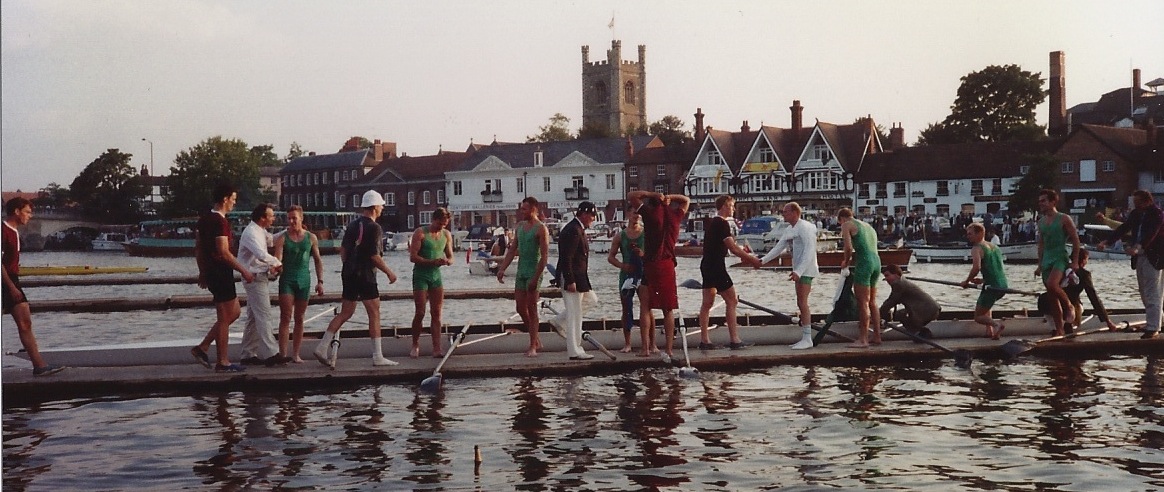Before the Redgrave era, the Oxford & Cambridge Boat Race was virtually the only rowing ever seen on British television. First contested at Henley-on-Thames in on 12 March 1829, the Boat Race moved to a stretch of the tidal Thames between Putney and Mortlake in 1845.
This is Matt Pincent’s 2011 Guide to the Boat Race Course.
Today, this 4 mile 374 yard stretch – sometimes referred to as ‘the Championship Course’ but more commonly as ‘the Tideway’ – is now the home waters of more than 40 rowing clubs and also plays host to ten races in the spring and autumn that attract hundreds of crews, thousands of rowers – both male and female of all ages – and every boat class from all over the UK – and further afield.
First staged on 10 August 1830 – in the year after the first Boat Race – the Wingfield Sculls is a side-by-side ‘match’ race for the title of Amateur Sculling Champion of the Thames and Great Britain. Instigated as a wager by barrister Henry Wingfield, the race was initially held between Westminster and Putney before moving to the Championship Course from Putney to Mortlake in 1861.
A womens race was established in 1929 which, with the exception of the two world wars, was contested until the early 1970s. It was re-instigated in 2007. Now raced in early November, the 2009 races were won by British Olympians Alan Campbell and Sophie Hosking.
Steve Fairbairn, a four-times Cambridge blue (1882-3, 1886-7) and subsequently a highly influential coach, founded the Head of the River Race in 1926. Famous for his maxim that ‘mileage makes champions’, Fairbairn conceived of the HORR as a target to aim for during the long hours of endurance training that make up the average oarsman’s winter.
Twenty three eights entered the first Head of the River Race on 12 December 1926 although only 21 made it to the water. Raced as a time trial – or ‘processional race’ – on the ebb tide from Mortlake to Putney, victory went to London Rowing Club in a time of 20 min 1 sec. The race grew steadily until, for logistical and safety reasons, the entry was capped at 420 eights around 1980. The 3780 competitors range cover the entire spectrum from complete novice to World and Olympic Champions.
Appropriately for an event that marks the end of winter training, it usually takes place on the Saturday of the weekend that marks the start of British Summer Time. Molesey Boat Club took the honours in the 2010 event. DRC Hanover’s second crew, who finished 307th out of the 388 finishers, can take some pride from the fact that their time of 19 mins 59.2 secs would have won the very first race!
A women’s eights race between Mortlake and Putney was first staged in 1927. Initially contested by Ace and Weybridge Ladies Amateur Rowing Club racing side-by-side, the two clubs returned for a rematch in 1928 and were joined by Alpha in a three boat race in 1929. With five entries, the Womens Eights Head of the River Race adopted the time trial format in 1930. Now held two weeks before the HORR in early March, entries have reflected the massive growth in womens rowing generally expanding from 27 in 1977 to 270 in 2003.
289 crews finished the 2009 race which was won by a composite of GB national squad oarswomen stroked by multi-Olympic medalist Kath Grainger. With the snappy crew name of Gloucester/Imperial College/Marlow/Reading University/Thames/University of London, the winning crew recorded a time of 18 mins 10.67 secs.
School and junior crews get the chance to race over the Championship Course in the Schools Head held on a weekday around the Womens’ Head determined by the tides and academic calender. Founded by Westminster School in 1946, 17 crews took part in the inaugural race, four sank and the event was deemed a great success! Originally a race for eights from London Corinthians Sailing Club to Westminster School Boat House, fours were admitted quite quickly and quads joined the party in 1987.
In the late 1980s, the course was lengthened – by moving the start up-river to the Bandstand – and subsequently split into two with a long start at the Mortlake end of the Championship Course and a short start remaining at Corinthians. Entries mushroomed, reaching a peak of around 390, making it necessary introduce measures to limit entries to around 300 crews on safety grounds. In 2010 the short course was dropped and all crews now race over the full Championship Course.
While entries are still dominated by the traditional rowing schools, the much broader participation base of British rowing has been reflected in a steady rise in entries – and category wins – from state schools and junior crews from non-school rowing clubs. 256 crews completed the course in 2010.
The Scullers Head of the River Race – for single sculls – was established by Vesta Rowing Club in 1954. Raced at the end of November over the full Championship Course from Mortlake, Jamie Kirkwood of Imperial College led home the 418 finishers in a time of 20 minutes 55.38 secs in the 2009 race.
The first Fours Head of the River was raced in 1955 as the Tradesmen’s Rowing Club’s Association Head of the River Fours. At the time, watermen and other people who worked with their hands were not considered to be truly ‘amateur’ by the Amateur Rowing Association and so raced under the auspices of the a separate governing body – the National Amateur Rowing Association.
Initially raced between Chiswick Steps and Putney Pier, the Fours Head was extended to the full Championship Course from Mortlake in 1990. Now held in mid November, the event is open to quad sculls, coxless and coxed fours. Even though entries are limited to 550 crews, the Fours Head remains the largest single race in British rowing. Sponsored by brewers Fuller Smith and Turner, the chance to attend the prize giving at the Griffin Brewery has become an additional incentive for competitors!
In 1982, Vesta added another date to the rowing calender when it established the Vesta Veterans’ International Eights Head of the River Race. Veteran crews – to be known as ‘Masters’ from the 2010 regatta season – compete in categories determined by the average ages of the eight rowers.
Raced on the Sunday morning of the HORR weekend in March, the direction of the course is determined by the tide tables. When raced from Mortlake, it is raced over the full Championship Course. When raced on the flood tide – in the same direction as the Boat Race as in 2010 – the race starts from Hammersmith Bridge to provide sufficient space above Putney Bridge to marshal the typical entry of around 200 crews in safety. 199 crews finished the 2010 race including six Vet G/H crews containing rowers aged over 70.
The Pairs Head of the River, which also accommodates double sculls, was first staged in 1971 and is raced in mid October over a ‘short’ course of 4,000 metres between Mortlake and Hammersmith Bridge. 372 crews finished the 2009 race.
Veterans also have the chance to race between Mortlake and Putney in fours and quads in the mid November Veterans Fours Head of the River.
Fairbairn’s contribution to both the Head and the Boat Race is commemorated on the Surrey towpath. The monument is the first mile marker for the Boat Race (and Wingfield Sculls) – or the start of the final exhausting mile for competitors in most of the head races.
It’s not only oarsmen and sailors who compete over the Championship Course. Every Easter weekend, hundreds of very weary canoeists traverse the course as they approach the finish of the 125-mile long Devices to Westminster International Canoe Marathon – the world’s longest annual canoe event.



